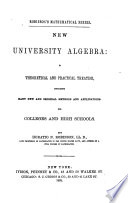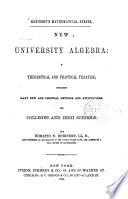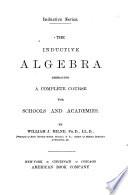 | William Smyth - Algebra - 1858 - 344 pages
...number by means of a table of logarithms, we multiply, therefore, the logarithm of the proposed number by the exponent of the power, to which it is to be raised; the number in the table corresponding to this product, will be the power sought. " • 4. Again, let... | |
 | Charles Davies, William Guy Peck - Mathematics - 1859 - 622 pages
...a* — a*+iOne may be divided by the other by subtractin" their exponents: thus, A quantity may he raised to any power by multiplying its exponent by the exponent of the power : thus, (a -»)-• = л'». Any root of a quantity may be extracted by dividing the exponent by the... | |
 | Charles Davies - Algebra - 1860 - 412 pages
...gives Again, to square *f3b, we have *f3b = \J \f"3b- hence, When the index of the radical is divisible by the exponent of the power to which it is to be raised, perform the division, leaving the quantity under the radical sign unchanged. Extraction of Roots of... | |
 | William Alfred Browne - 1863 - 486 pages
...example, 54-f-52= (5 x 5 x 5 x 5) -5- (5 x 5 = 52. 828. A power of any number is raised to any other given power by multiplying its exponent by the exponent of the power to which it is to be raised. For example (42)2 (which means that 4 is to be raised to the second power,) = 42 x 45=44. OS iH CO... | |
 | Horatio Nelson Robinson - Algebra - 1863 - 432 pages
...exponents. To explain the origin of this method of indicating roots, we observe that a quantity is raised to any power, by multiplying its exponent by the exponent of the required power. Conversely, any root of a quantity may be obtained, by dividing the exponent of the... | |
 | Horatio Nelson Robinson - Algebra - 1864 - 444 pages
...exponents. To explain the origin of this method of indicating roots, we observe that a quantity is raised to any power, by multiplying its exponent by the exponent of the required power. Conversely, any root of a quantity may be obtained, by dividing the exponent of the... | |
 | James Pryde - Mathematics - 1878 - 508 pages
...result as before. ( 15 ) To PERFORM INVOLUTION nr LOGARITHMS. Multiply the logarithm of the given number by the exponent of the power to which it is to be raised, and the product will be the logarithm of the required power. » EXAMPLE. Find the cube of 307146. L... | |
 | James Pryde - 1878 - 520 pages
...result as before. ( 16 ) To PERFORM INVOLUTION RY LOGARITHM8. Multiply the logarithm of the given number by the exponent of the power to which it is to be raised, and the product will be the logarithm of the required power. EXAMPLE. Find the cube of 30-7146. L 30-7146... | |
 | William James Milne - Algebra - 1881 - 360 pages
...the root. For, since in raising a quantity to a given power we multiply the exponent of the quantity by the exponent of the power to which it is to be raised, in finding a root the exponent of the quantity should be divided by the index of the root. fl *..„..,... | |
 | Henry Law - 1884 - 568 pages
...is, «" -r- xm = «<" ~ "'>. 3. The involution of any power of a quantity to some power is performed by multiplying its exponent by the exponent of the power to which it is to be raised ; that is, the nth power of af"ie,xn-'". 4. The extraction of the root of any power is performed by... | |
| |